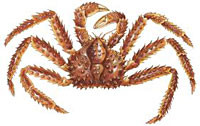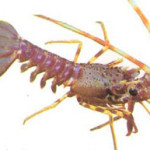
Paralithodes camtschatika
Originating from the Sea of Okhotsk in the Camchatca region of eastern Russia, the red king crab (Paralithodes camtschatica) was introduced to parts of the Russian waters of the Barents Sea in the 1960’s. In the mid 1970’s, individual specimens started to appear as bycatch on both sides of the shared Russian/Norwegian border. Since that time, bycatch numbers have increased significantly in the region.
The king crab is a valuable food source and is the most commercially important of all crabs. Whilst a number of studies have examined the optimum harvesting strategies for the species in the region, very little has been done to understand the potential ecological impact that the species will have in non-native waters.
The crab’s diet appears to include a wide range of organisms, especially polychaetes worms, small bivalves such as clams and echinoderms like sea urchins and starfish. It consumes large quantities of food relative to its body size; creating concern that serious depletion of some benthic (bottom dwelling) species may occur where there are high concentrations of crabs in a limited area. The crab may well be a significant food competitor of bottom-feeding fishes. The red king crab population is dramatically rising in numbers and spreading in distribution. The Barents Sea population has increased six-fold since 1995, with an estimated 12 million members of the species now resident.
The crabs can be found at depths ranging from the shoreline down to 400 metres, depending on size, age and season.
One of the largest crabs, in the Arctic it can grow up to 1.5m and weigh up to 10 kg. King crabs are unique in that they have only 6 legs while most crabs have 8. When alive, it is actually dark burgundy in colour.
There are two other species of king crab, but they are not found in these waters. These are the blue king crab (Paralithodes platypus) and the smaller brown or golden king crab (Lithodes aequispina).









Social Profiles